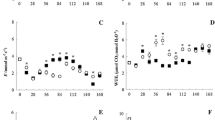Abstract
The time processes of photosynthetic induction responses to various irradiances in Korean pine (Pinus koraiensis) seedlings grown in open-light environments and in understory of forest were studied in an area near the Research Station of Changbai Mountain Forest Ecosystems, Jilin Province, China from July 15 to August 5, 1997. The results showed that at 200 μmol·m−2·s−1 photosynthetic photon flux density (PPFD) and 500 μmol·m−2·s−1 PPFD, the induction time for the photosynthetic rates of understory-grown seedlings to reach 50% and 90% steady-state net photosynthetic rates was longer than that of the open-grown seedlings. The induction responses of open-growth seedlings at 500 μmol·m−2·s−1 PPFD were slower than those at 200 μmol·m−2·s−1 PPFD, but it was the very reverse for understory-growth seedlings, which indicates that the photosynthetic induction times of Korean pine seedlings grown in the understory depended on the sunfleck intensity.
Similar content being viewed by others
References
Chazdon, R.L. 1988. Sunflecks and their importance to forest understory plants [J]. Adv. Ecol. Res.,18: 1–63.
Chazdon, R.L. and Pearcy, R.W. 1991. The importance of sunflecks for forest understory plants [J]. Bioscience,41: 760–766.
Kuppers, M., Timm, H., Orth, K.,et al. 1996. Effects of light environment and succession status on lightflecks use by understory trees of temperate and tropical forests [J]. Tree Physiol.,16: 69–80.
Pons, T.L., and Pearcy, R.W. 1992. Photosynthesis in flashing light in soybean leaves grown in different conditions. II. Efficiency of utilization of lightflecks [J]. Plant, Cell and Environ.,15: 577–584.
Stenberg, P., Delucia, E.H., Schoetle, A.W. and Smolander, H. 1995. Photosynthetic light capture and processing from cell to canopy [C]. In: Smith, W.K., and Hinckley, T.M. (eds.) Resource Physiology of Conifers: Acquisition, Allocation, and Utilization. New York: Academic Press, p3–38.
Tang, Y., Hiroshi, K., Mitsumasa, S., and Izumi, W. 1994. Characteristics of transient photosynthesis inQuercus serrata seedlings grown under lightfleck and constant light regimes [J]. Ocecologia,100: 463–469.
Author information
Authors and Affiliations
Additional information
Biograph: ZHOU Yong-bin (1970-), female, associate professor of Shenyang Agricultural University, Shenyang 110161, P.R. China.
Responsible editor: Song Funan
Rights and permissions
About this article
Cite this article
Zhou, Yb., Yin, Y., Liu, Xs. et al. Photosynthetic induction responses ofPinus koraiensis seedlings grown in different light environments. J. of For. Res. 15, 246–248 (2004). https://doi.org/10.1007/BF02911034
Received:
Issue Date:
DOI: https://doi.org/10.1007/BF02911034




